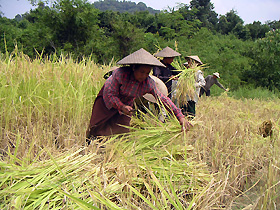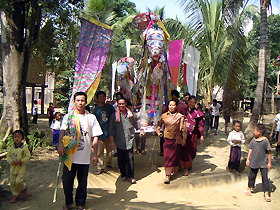| Period: 1 October - 31 December 2005. Country: Laos |
| (1) Social Change and Cultural Transformation of the Lue people
in Northern Laos |
| YOSHIDA Kayoko (Division of Southeast Asian Area Studies) |
| Key Words: Lue People, System of Mutual Assistance, Local Community, Social Network, Inter-Ethnic Relationship |

Photo 1: Harvesting rice jointly |

Photo 2: Celebrating the Ook-Pansa Festival |
(2) My main interest is the independence of people in the context of changing society and culture. First, I hope to elucidate the various types of relationships which constitute a rural community in Laos, and examine how people understand their own positions and roles, and how they cope with these norms. Second, I hope to look at how people who are labeled or label themselves as members of an ethnic people contribute or try to contribute to the forging of their ethnic identity. Further, in the near future I wish to create an ethnography of the area, focusing on the Lue people, in order to contribute to the study of social change and cultural transformation.
(3) I have carried out a field survey in NT village in the northern part of Luang Praban Province, Lao P.D.R., since September 2004. The aim of the present field research (October - December 2005) was to supplement the survey and reexamine the former data. Through my prolonged fieldwork, I have gained a grasp of the people's local knowledge or wisdom in their daily living, and deepened my understanding of various mechanisms which maintain the local community. In particular, my experiences during the past three months aroused my interest in the system of mutual assistance based on neighborhood, blood relationships and the division of labor by age and sex.
In concrete terms, during the major village events, which were held during the current research period, I was able to observe the structure of each rite, the division of responsibilities and the cooperative relationship between relatives. Even though villagers claim that customs are "traditional," almost all the events have been transformed in reality. Moreover, these changes always reflect the people's real situation and social relationships in which they are involved. Therefore, it may be that we can understand the various relationships that are hidden in daily life and the social changes in the area by examining the various facts seen in the events.
In addition, because my stay coincided with the period of the second harvest, I engaged in agricultural work with villagers and was able to look at the "principles" and "practical application" of mutual assistance. In the village, labor exchanges fulfill a function within relationships in which people agree to help each other. Moreover the order of priority of mutual assistance changes in accordance with people's expectations, strategies and negotiations. In other words, neighborhood and family relationships are necessary but not sufficient conditions for explaining cooperation. I actually felt that in order to understand the system of mutual assistance, it is necessary not only to listen to people's explanations, but also to grasp the facts of who is helping whom and how in practice.
Furthermore, as I looked around all the rice fields, I discovered that different places vary considerably in terms of the quantity of water, soil quality, and distance from the village. Considering this, it is not reasonable to judge the crop size based merely on the field acreage. Rice fields are important assets, passed down from ancestors, so proximity between fields tends to signify a close family relationship. Moreover, collaborative work to manage water and keep wild animals at bay is very important for considering the social relationships in villages. Another positive outcome of this work was to help me to realize the usefulness of the methodology of integrating humanities and the natural sciences.
After finishing the field survey in the village, I had the opportunity to make a presentation at the National University of Laos under the sponsorship of the Laos Field Station, for Lao students and teachers("khwamhu thongthin: ngan soiluakan lae ngan nai sonnabot"(The Local Knowledge: System of Mutual Assistance in Rural Community), Presentation of Research in Laos by Japanese Researcher, 2005.12.14). My Lao language ability was not fluent by any means, but the participants seemed to be attracted to the study and asked me many questions. I hope my presentation had an impression on them, and will become the first step in the return of the results of my research to the local people.
|


 21st Century COE Program
-Aiming for COE of Integrated Area Studies-
21st Century COE Program
-Aiming for COE of Integrated Area Studies-